Schlechta K. Nonmonotonic Logics: Basic Concepts, Results, and Techniques
Подождите немного. Документ загружается.

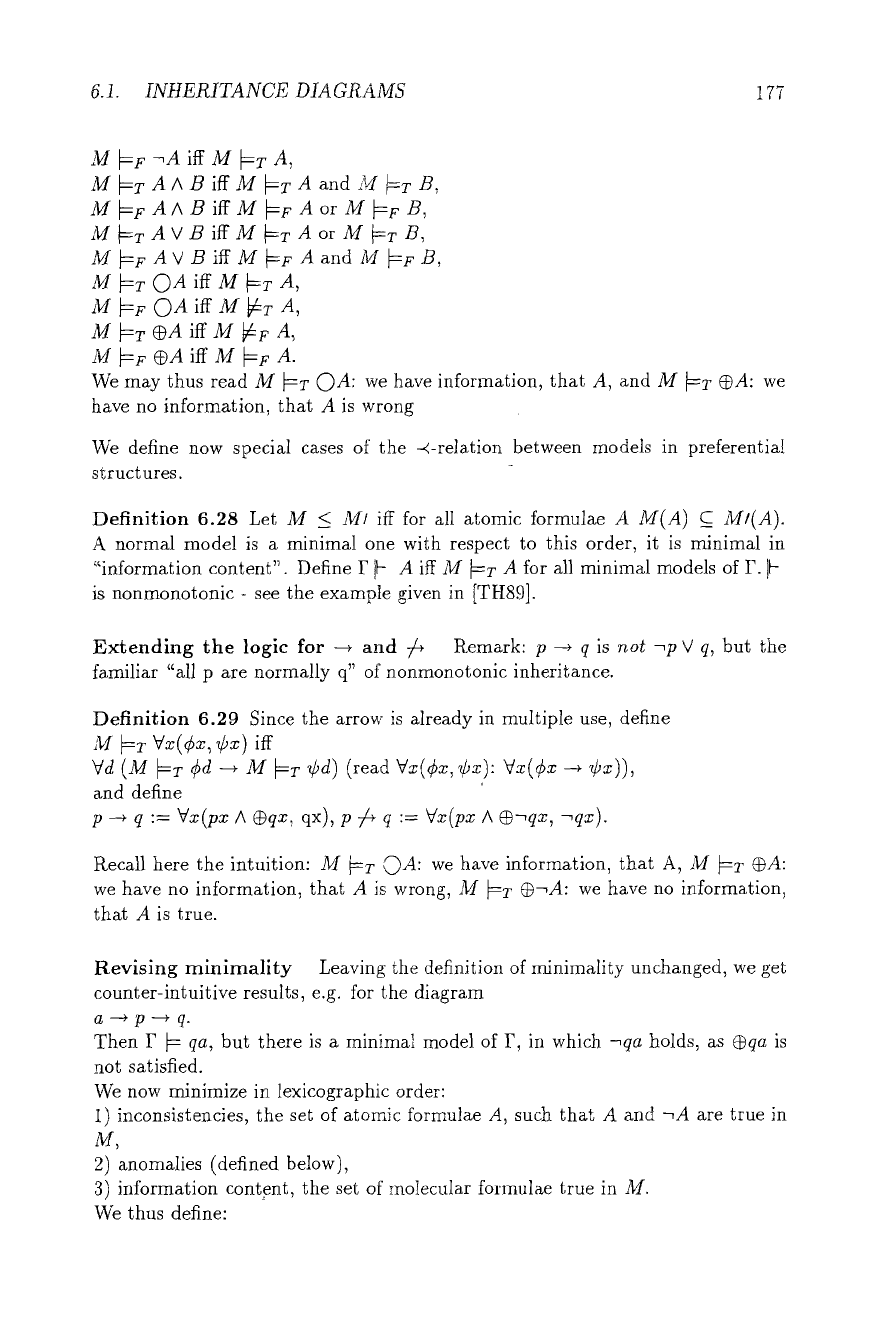
6.1. INHERITANCE DIAGRAMS
177
M VF -,A iff M ~T A,
M~TAABiffM~TAandM~TB,
M ~F AA B iff M ~r A or M ~F B,
M ~T A V B iff M ~T A or M ~T B,
M~rAVBiffM~FAand M ~F/3,
,4J PT OA iff M ~T A,
M ~v 0 A iff M ~=T A,
M ~T | iff M ~, A,
M
~=F
| iff M ~F A.
We may thus read M ~T 0A: we have information, that A, and M ~T •A: we
have no information, that A is wrong
We define now special cases of the -<-relation between models in preferential
structures.
Definition 6.28 Let M < M/ iff for all atomic formulae
A M(A) C_ MI(A).
A normal model is a minimal one with respect to this order, it is minimal in
"information content". Define F il- A iff M ~T A for all minimal models of F. Ib
is nonmonotonic - see the example given in [TH89].
Extending the logic for .4 and 74 Remark: p -4 q is
not ~p V q,
but the
familiar "all p are normally q" of nonmonotonic inheritance.
Definition 6.29 Since the arrow is already in multiple use, define
M ~r Vx(r Cx) iff
Vd (M ~T Cd ~ M
PT
~bd) (read Vz(r ~bx): Vx(r .4 r
and define
p --4 q :=
Vx(px A Oqx,
qx), p 7/+ q :=
Vx(px A G~qx, -~qx).
Recall here the intuition: M ~T @A: we have information,
that
A, M ~:r |
we have no information, that A is wrong, M ~T O-,A: we have no information,
that A is true.
Revising minimality Leaving the definition of minimality unchanged, we get
counter-intuitive results, e.g. for the diagram
a-4p--~q.
Then F ~
qa,
but there is a minimal model of P, in which
-,qa
holds, as
|
is
not satisfied.
We now minimize in lexicographic order:
I) inconsistencies, the set of atomic formulae A, such that A and -~A are true in
M,
2) anomalies (defined below),
3) information content, the set of moIecular formulae true in M.
We thus define:
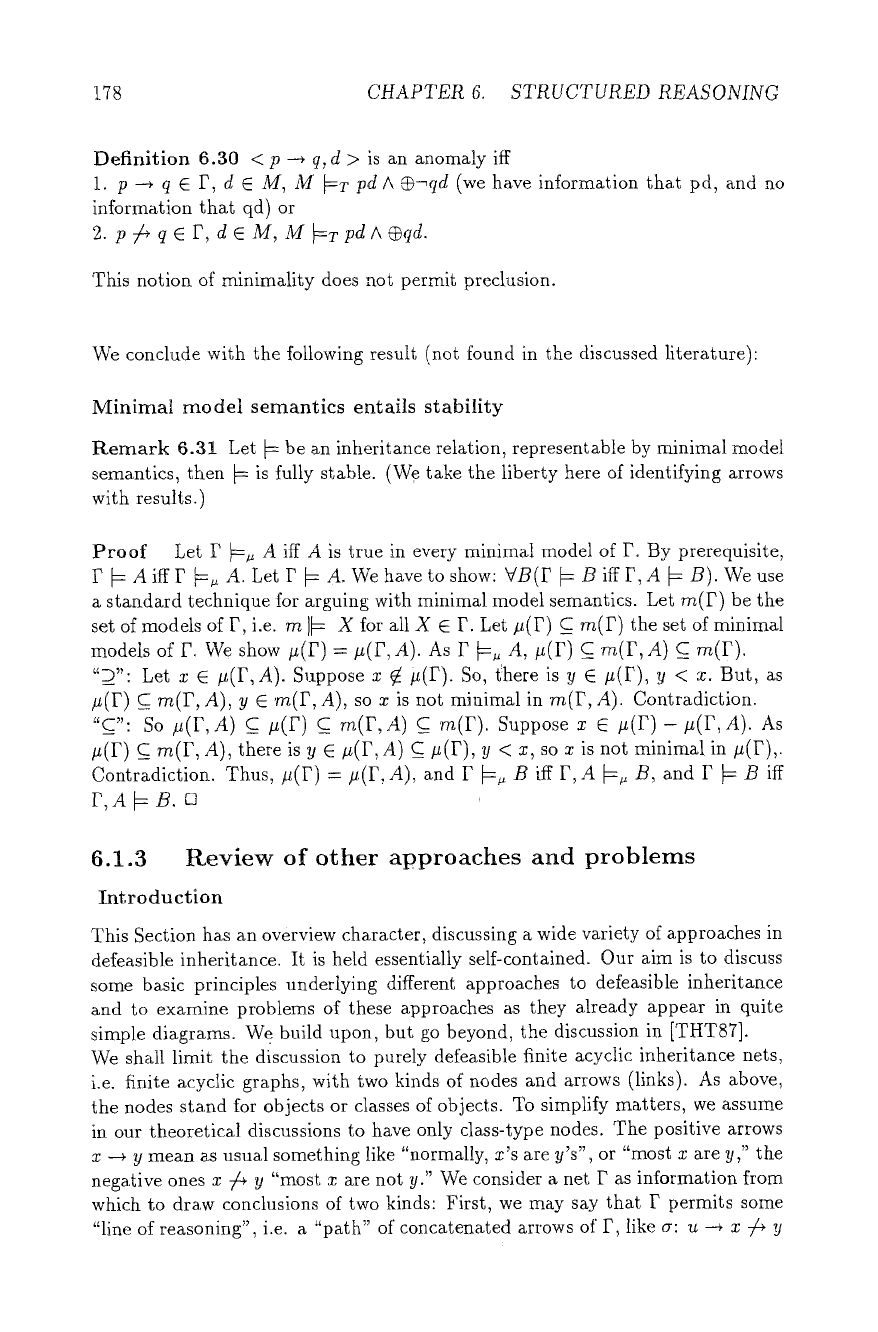
~[78 CHAPTER 6. STRUCTURED REASONING
Definition 6.30 < p --* q, d > is
an anomaly
iff
1. p ~ q E F, d E M, M ~T pd A G~qd (we have information that pd, and no
information that qd) or
2. p74 q E F, dE M, M ~T pdA Gqd.
This notion of minimality does not permit preclusion.
We conclude with the following result (not found in the discussed literature):
Minimal model semantics entails stability
Remark 6.31 Let ~ be an inheritance relation, representable by minimal model
semantics, then ~ is fully stable. (We take the liberty here of identifying arrows
with results.)
Proof Let P ~ A iff A is true in every minimal model of F. By prerequisite,
r ~ a iff F ~ A. Let F ~ A. We have to show: VB(F ~ B iff F, A ~ B). We use
a standard technique for arguing with minimal model semantics. Let re(P) be the
set of models of F, i.e. rn I~ X for all X E P. Let #(P) C m(I') the set of minimal
models of F. We show #(F) = #(F, A). As F ~, A, t*(F) C re(F, A) C_ re(F).
"D":
.(r,a).
Suppose x ~ >(P). So, t~here is y E #(P), y < z. But, as
#(F) C re(r, A), y E ,rn(P, A), so x is not minimal in re(F, A). Contradiction.
"C_": So #(F,A) C #(P) C m(F,A) C rn(P). Suppose x E >(P) - #(F,A). As
>(P) C_ m(I', A), there is y E #(I7', A) C #(P), y < x, so x is not minimal in p(P),.
Contradiction. 2~hus, #(I') = #(P, A), and P ~ B iff F, A ~ B, and P ~ B iff
P,A ~/?, c3
6.1.3 P~eview of other approaches and problems
Introduction
This Section has an overview character, discussing a wide variety of approaches in
defensible inheritance. It is held essentially self-contained. Our aim is to discuss
some basic principles underlying different approaches to defensible inheritance
and to examine problems of these approaches as they already appear in quite
simple diagrams. We build upon, but go beyond, the discussion in [THT87].
We shall limit the discussion to purely defensible finite acyclic inheritance nets,
i.e. finite acyclic graphs, with two kinds of nodes and arrows (links). As above,
the nodes stand for objects or classes of objects. To simplify matters, we assume
in our theoretical discussions to have only class-type nodes. The positive arrows
z --4 y mean as usual something like "normally, x's are y's", or "most x are y," the
negative ones x 74 y "most x are not y." We consider a net F as information from
which to draw conclusions of two kinds: First, we may say that P permits some
"line of reasoning", i.e. a "path" of concatenated arrows of F, like or: u --~ x 74 y
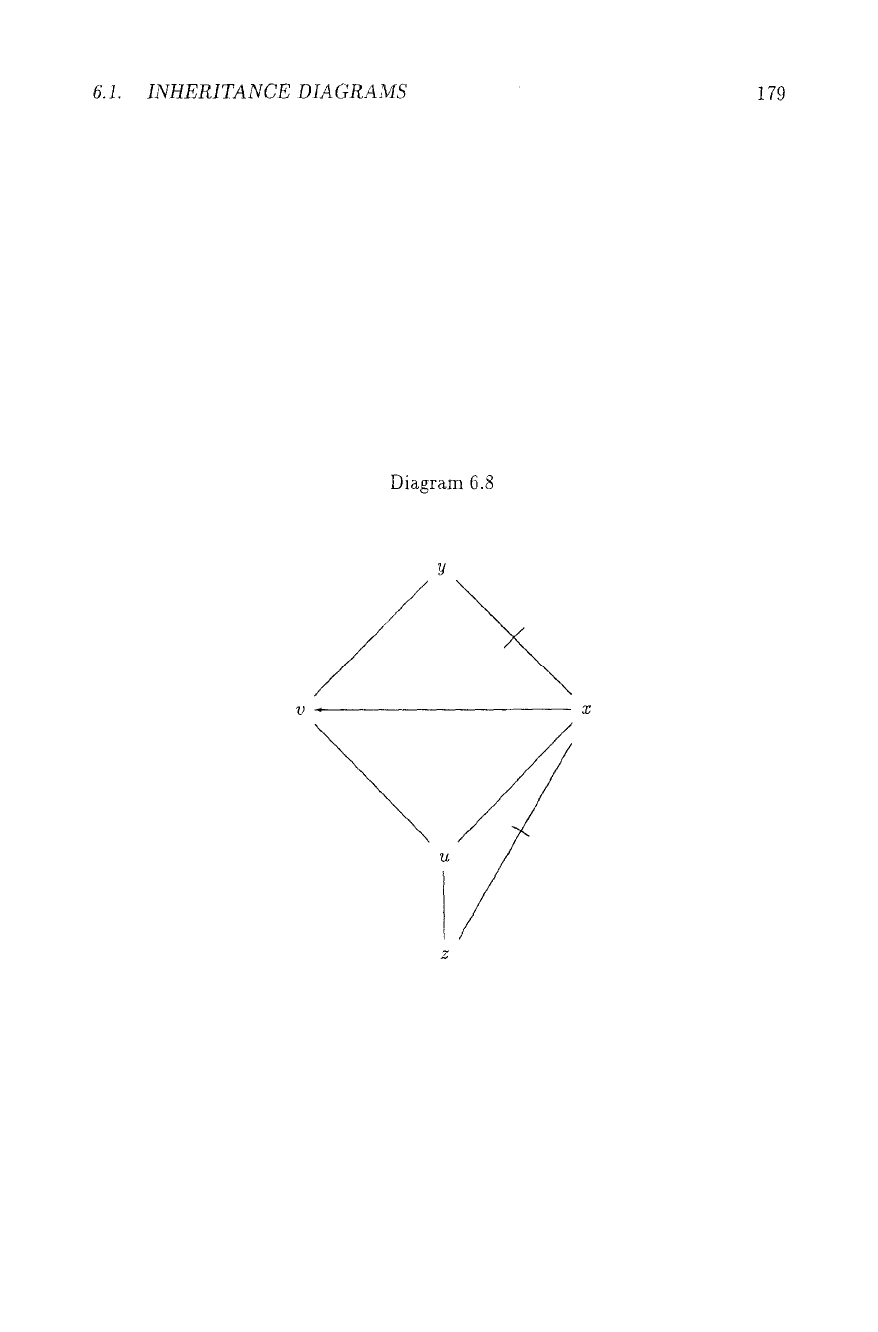
\
c~
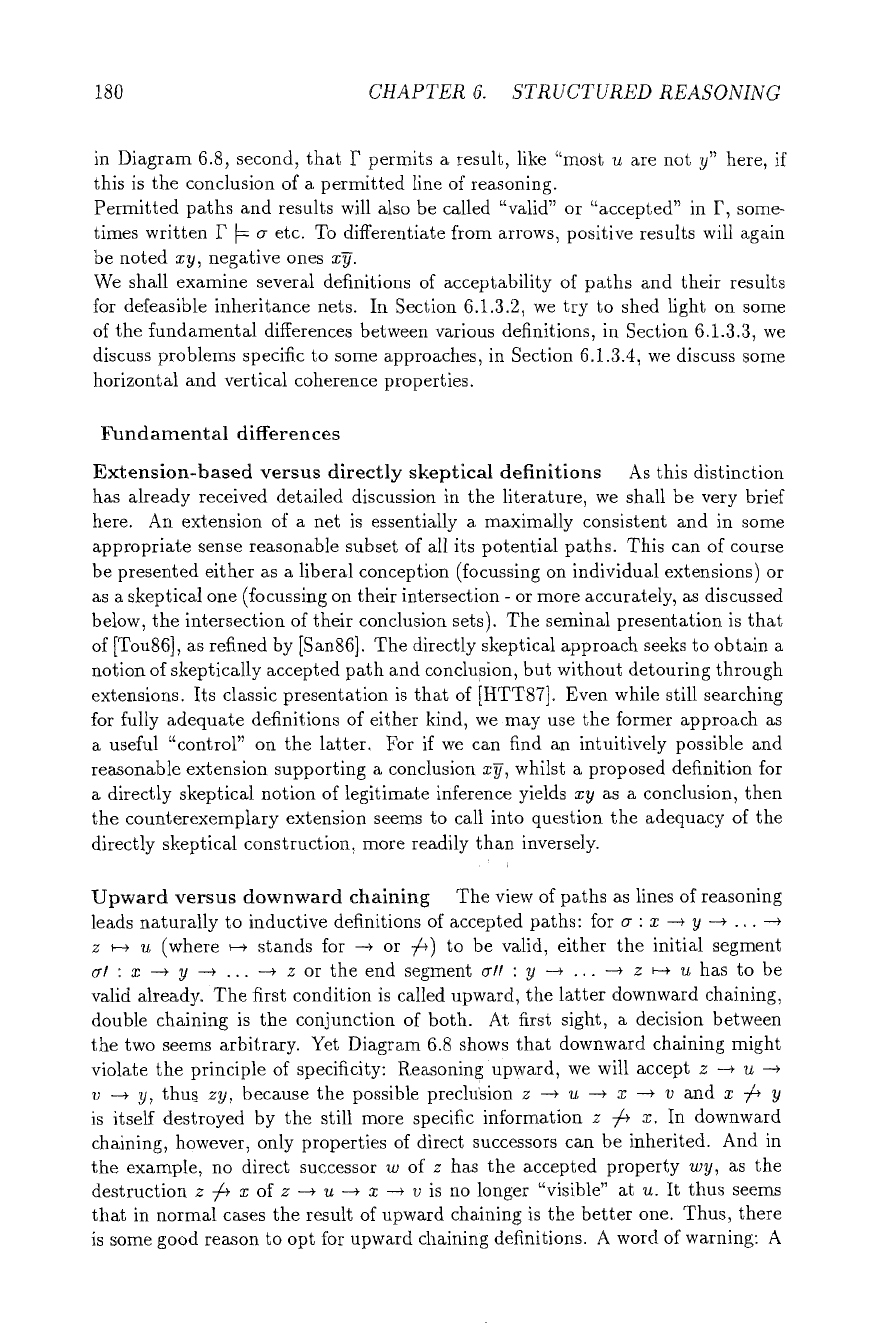
180
CHAPTER 6. STRUCTURED REASONING
in Diagram 6.8, second, that F permits a result, like "most u are not y" here, if
this is the conclusion of a permitted line of reasoning.
Permitted paths and results will also be called "valid" or "accepted" in F, some-
times written F ~ cr etc. To differentiate from arrows, positive results will again
be noted
xy,
negative ones aT d.
We shall examine several definitions of acceptability of paths and their results
for defensible inheritance nets. In Section 6.1.3.2, we try to shed light on some
of the fundamental differences between various definitions, in Section 6.1.3.3, we
discuss problems specific to some approaches, in Section 6.1.3.4, we discuss some
horizontal and vertical coherence properties.
Fundamental differences
Extension-based versus directly skeptical definitions As this distinction
has already received detailed discussion in the literature, we shall be very brief
here. An extension of a net is essentially a maximally consistent and in some
appropriate sense reasonable subset of all its potential paths. This can of course
be presented either as a liberal conception (focussing on individual extensions) or
as a skeptical one (focussing on their intersection - or more accurately, as discussed
below, the intersection of their conclusion sets). The seminal presentation is that
of [Tou86], as refined by [San86]. The directly skeptical approach seeks to obtain a
notion of skeptically accepted path and conclusion, but without detouring through
extensions. Its classic presentation is that of [HTT87]. Even while still searching
for fully adequate definitions of either kind, we may use the former approach as
a useful "control" on the latter. For if we can find an intuitively possible and
reasonable extension supporting a conclusion xg, whilst a proposed definition for
a directly skeptical notion of legitimate inference yields xy as a conclusion, then
the counterexemplary extension seems to call into question the adequacy of the
directly skeptical construction, more readily than inversely.
i
Upward versus downward chaining The view of paths as lines of reasoning
leads naturally to inductive definitions of accepted paths: for cr : x -~ y --~ ... -+
z ~-~ u (where ~-~ stands for -~ or 74) to be valid, either the initial segment
cq : x --+ y -~ ... -~ z or the end segment ~lt : y ~ ... -+ z ~-~ u has to be
valid already. The first condition is calIed upward, the latter downward chaining,
double chaining is the conjunction of both. At first sight, a decision between
the two seems arbitrary. Yet Diagram 6.8 shows that downward chaining might
violate the principle of specificity: Reasoning upward, we will accept z -~ u --~
v --~ y, thus
zy,
because the possible preclu'sion z -~ u --+ x --+ v and z ;/* y
is itself destroyed by the still more specific information z ~ x. In downward
chaining, however, only properties of direct successors can be inherited. And in
the example, no direct successor w of z has the accepted property
wy,
as the
destruction z 74 x of z --~ 'u -* x --~ v is no longer "visible" at u. It thus seems
that in normal cases the result of upward chaining is the better one. Thus, there
is some good reason to opt for upward chaining definitions. A word of warning: A
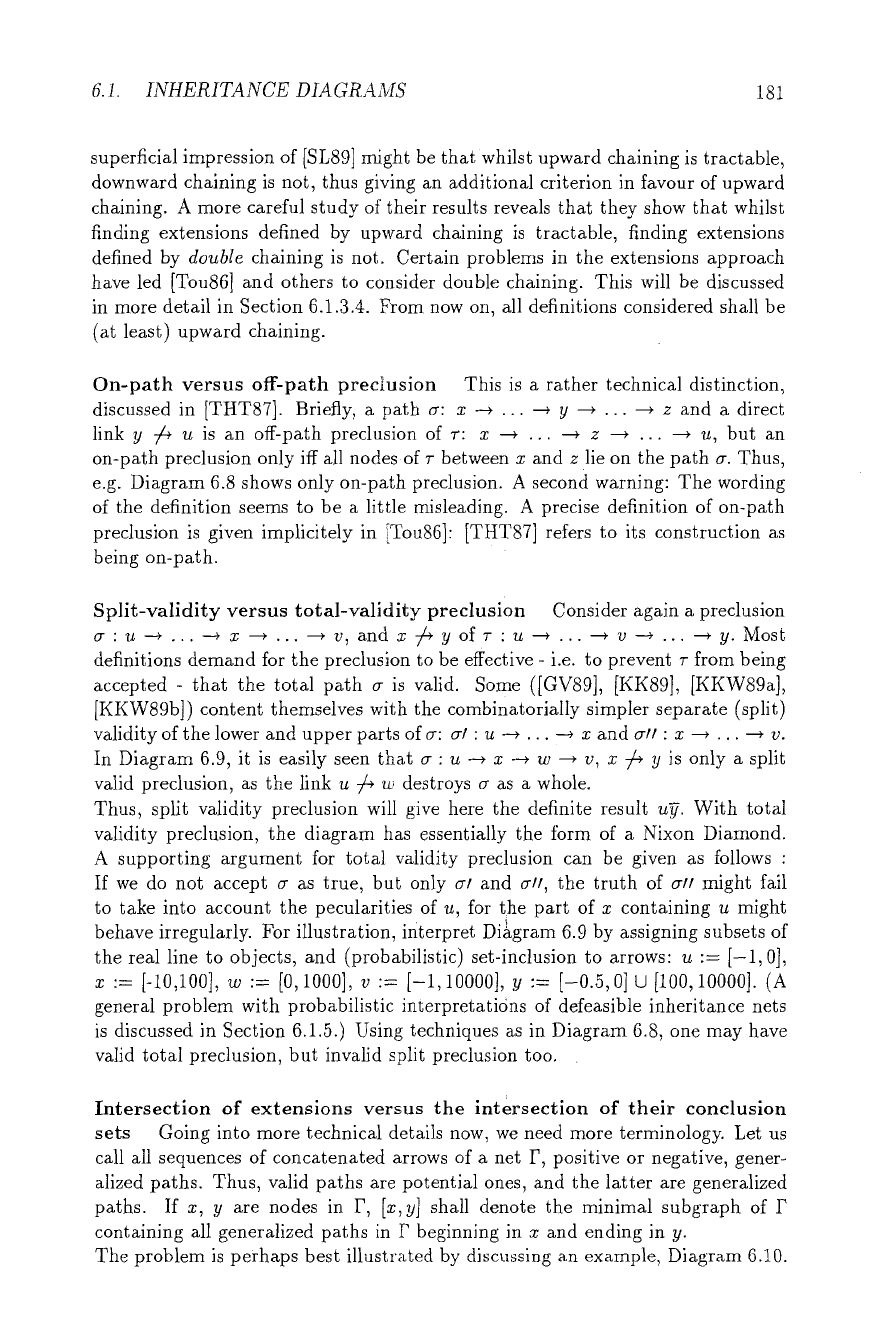
6.1. INHERITANCE DIAGRAMS
181
superficial impression of [SL89] might be that whilst upward chaining is tractable,
downward chaining is not, thus giving an additional criterion in favour of upward
chaining. A more careful study of their results reveals that they show that whilst
finding extensions defined by upward chaining is tractable, finding extensions
defined by
double
chaining is not. Certain problems in the extensions approach
have led [Tou86] and others to consider double chaining. This will be discussed
in more detail in Section 6.1.3.4. Prom now on, all definitions considered shall be
(at least) upward chaining.
On-path versus off-path preclusion This is a rather technical distinction,
discussed in [THT87]. Briefly, a path ~r: x -4 ... ~ y -4 ... --~ z and a direct
link y 74 u is an off-path preclusion of r: x --* ... -4 z --* ... --~ u, but an
on-path preclusion only iff all nodes of r between z and z lie on the path c~. Thus,
e.g. Diagram 6.8 shows only on-path preclusion. A second warning: The wording
of the definition seems to be a little misleading. A precise definition of on-path
preclusion is given implicitely in [Tou86]: [THT87] refers to its construction as
being on-path.
Split-validity versus total-validity preclusion Consider again a preclusion
~r : u .4 ... --4 x .4 ... --~ v, and x 7z* y oft : u -4 ... ~ v --~ ... ~ y. Most
definitions demand for the preclusion to be effective - i.e. to prevent r from being
accepted - that the total path c~ is valid. Some ([GV89], [KK89], [KKW89a],
[KKW89b]) content themselves with the combinatorially simpler separate (split)
validity of the lower and upper parts of ~r: cr! : u ~ . .. --* x and o-II : x -+ ... -4 v.
In Diagram 6.9, it is easily seen that ~r : u -4 x --+ w -4 v, x ~ y is only a split
valid preclusion, as the link u ~ w destroys ~r as a whole.
Thus, split validity preclusion will give here the definite result u~. With total
validity preclusion, the diagram has essentially the form of a Nixon Diamond.
A supporting argument for total validity preclusion can be given as follows :
If we do not accept ~ as true, but only or1 and all, the truth of cql might fail
to take into account the pecularities of u, for the part of x containing u might
behave irregularly. For illustration, interpret Diagram 6.9 by assigning subsets of
the real line to objects, and (probabilistic) set-inclusion to arrows: u := [-1, 0],
x := [-10,100], w := [0, 1000], v := [-1, 100001, y := [-0.5, 0] U [100, 10000]. (A
general problem with probabilistic interpretati6ns of defensible inheritance nets
is discussed in Section 6.1.5.) Using techniques as in Diagram 6.8, one may have
valid total preclusion, but invalid split preclusion too.
Intersection of extensions versus the intersection of their conclusion
sets Going into more technical details now, we need more terminology. Let us
call all sequences of concatenated arrows of a net F, positive or negative, gener-
alized paths. Thus, valid paths are potential ones, and the latter are generalized
paths. If x, y are nodes in F, [x,y] shall denote the minimal subgraph of F
containing all generalized paths in F beginning in x and ending in y.
The problem is perhaps best illustrated by discussing an example, Diagram 6.10.
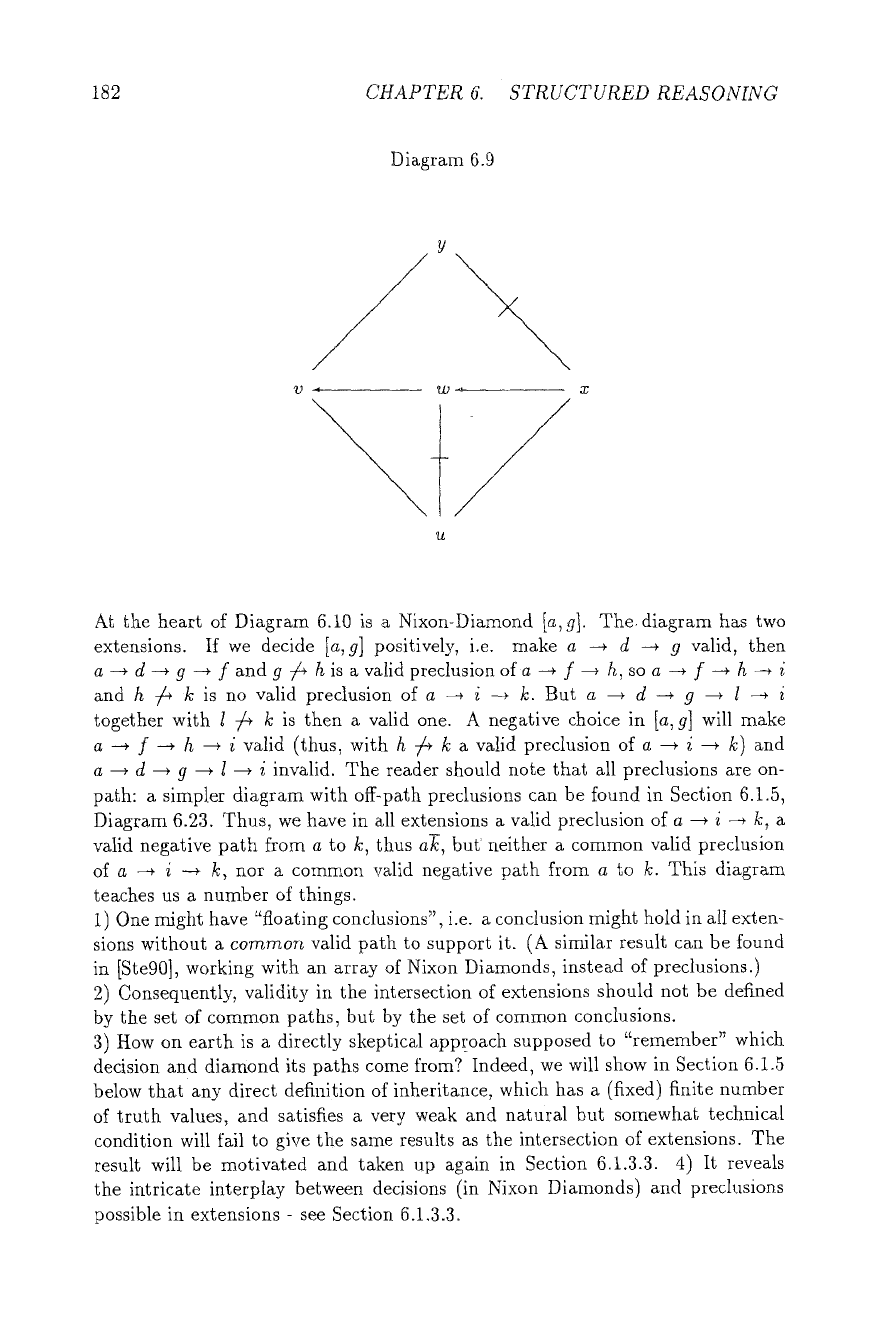
182
CHAPTER 6. STRUCTURED REASONING
Diagram 6.9
Y
~- W -~ X
lz
At the heart of Diagram 6.10 is a Nixon-Diamond
[a,g].
The.diagram has two
extensions. If we decide [a, 9] positively, i.e. make a --+ d --* 9 vMid, then
a --+ d -+ g -+ f and g 74 h is a valid preclusion of a --+ f --~ h, so a --~ f -+ h --* i
and h 74 k is no valid preclusion of a ~ i --+ k. But a --+ d --~ g --+ l -~+ i
together with 1 74 k is then a valid one. A negative choice in [a, g] will make
a --4 f --+ h --+ i valid (thus, with h 74 k a valid preclusion of a ~ i + /c) and
a --+ d ~ 9 -+ I --+ i invalid. The reader should note that all preclusions are on-
path: a simpler diagram with off-path preclusions can be found in Section 6.1.5,
Diagram 6.23. Thus, we have in all extensions a valid preclusion of a --+ i --+ ~:, a
valid negative path from a to k, thus a~, but ~ neither a common valid preclusion
of a --~ i ~ k, nor a common valid negative path from a to h. This diagram
teaches us a number of things.
1) One might have "floating conclusions", i.e. a conclusion might hold in all exten-
sions without a
common
valid path to support it. (A similar result can be found
in [Ste90], working with an array of Nixon Diamonds, instead of preclusions.)
2) Consequently, validity in the intersection of extensions should not be defined
by the set of common paths, but by the set of common conclusions.
3) How on earth is a directly skeptical approach supposed to "remember" which
dedsion and diamond its paths come from? Indeed, we will show in Section 6.1.5
below that any direct definition of inheritance, which has a (fixed) finite number
of truth values, and satisfies a very weak and natural but somewhat technical
condition will fail to give the same results as the intersection of extensions. The
result will be motivated and taken up again in Section 6.1.3.3. 4) It reveals
the intricate interplay between decisions (in Nixon Diamonds) and preclusion s
possible in extensions - see Section 6.1.3.3.
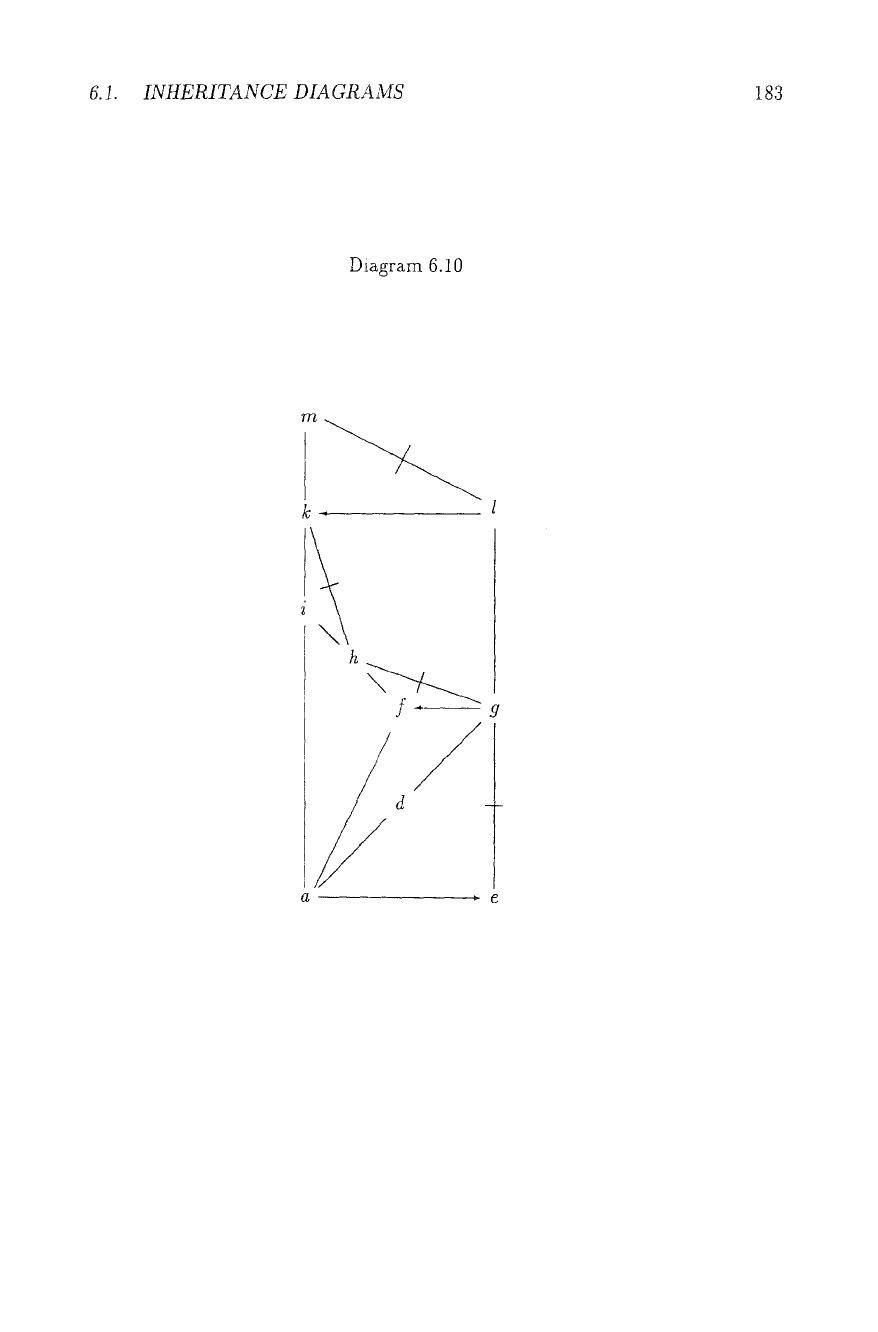
6.1. INHERITANCE DIAGRAMS !83
Diagram 6.10
rn
h
f~ 9
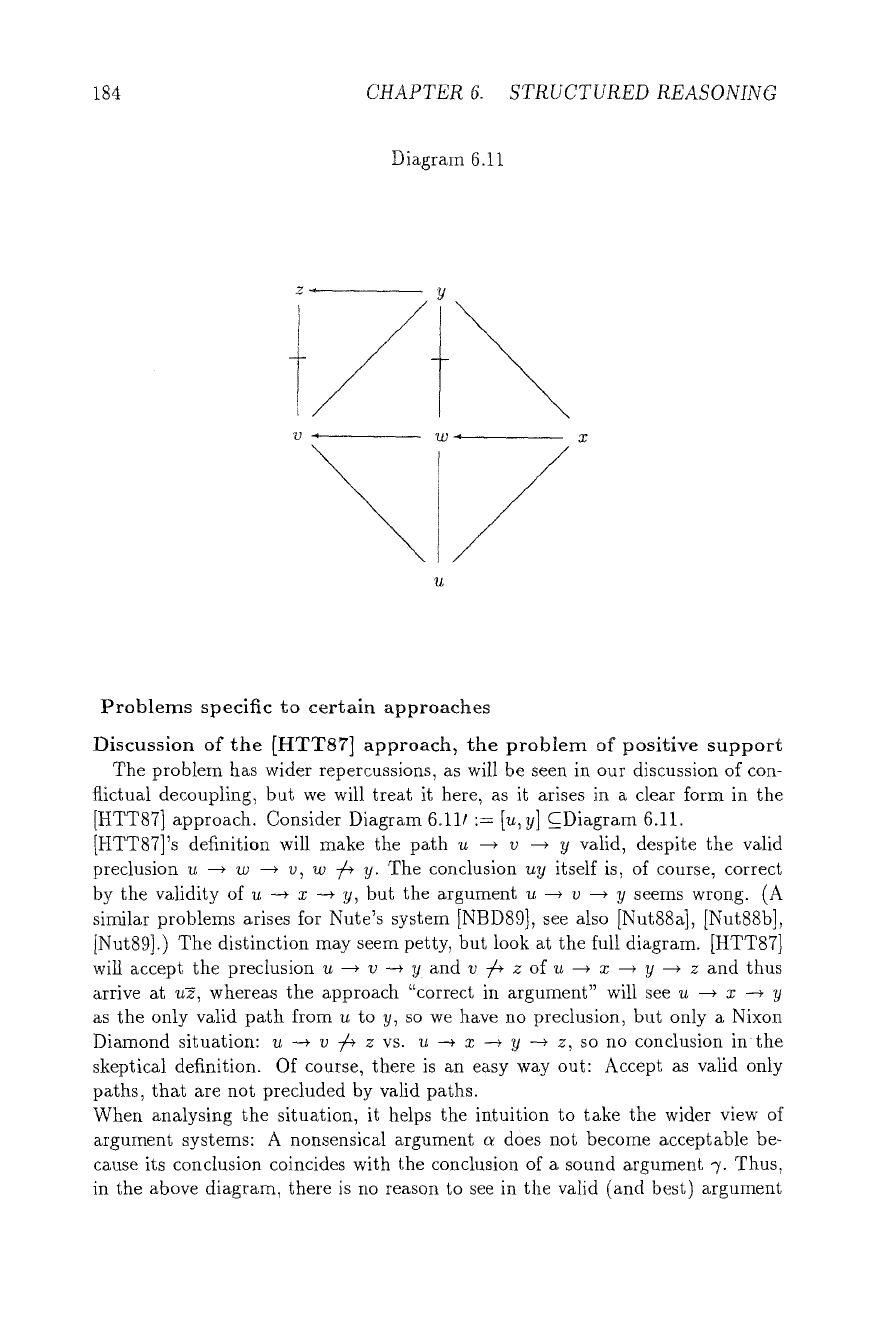
184
CHAPTER 6. STRUCTURED REASONING
Diagram 8.11
z~ y
T/ 2
2/
Problems specific to certain approaches
Discussion of the [HTT87] approach, the problem of positive support
The problem has wider repercussions, as will be seen in our discussion of con-
flictual &coupling, but we will treat it here, as it arises in a clear form in the
[HTT87] approach. Consider Diagram 6.11I := [u, y] C_Diagram 6.11.
[HTT87]'s definition will make the path u --* v -~ y valid, despite the valid
preclusion u + w + v, w 7z~ y. The conclusion
uy
itself is, of course, correct
by the validity of u -* x --* y, but the argument u ~ v -~ y seems wrong. (A
similar problems arises for Nute's system [NBD89], see also [Nut88a], [Nut88b],
[Nut89].) The distinction may seem petty, but look at the full diagram. [HTT87]
will accept the preclusion u + v --* y and v 74 z of u -~ z --* y -~ z and thus
arrive at ug, whereas the approach %orrect in argument" will see u --~ x --~ y
as the only valid path from u to y, so we have no preclusion, but only a Nixon
Diamond situation: u --~ v 74 z vs. u--, x ~ y ~ z, so no conclusion in the
skeptical definition. Of course, there is an easy way out: Accept as valid only
paths, that are not precluded by valid paths.
When analysing the situation, it helps the intuition to take the wider view of
argument systems: A nonsensical argument c~ does not become acceptable be-
cause its conclusion coincides with the conclusion of a sound argument 7- Thus,
in the above diagram, there is no reason to see in the valid (and best) argument

6.!. INHERITANCE DIAGRAMS
185
Diagram 6.12
f
d
q C
a
u --+ z --+ 9 positive support for the "bad" argument u --~ v --+ y. A - for our
inductive definition - totally different situation is described by Diagram 6.12.
Here, the argument a --* c -+ b, together with c ~ e destroys a ~ b --* e, so in
the next step of the inductive definition, neither the argument a --~ b --+ e 7~ f,
nor the comparison via a ---+ b --~ e --4 d are considered any more. But, this
has nothing to do with our acceptance of a --~ c --~ f, as replacing c -+ f by
c 74 f, resulting in Nixon-Diamond, shows. Of course, one may argue against the
inductive process itself and compare
all
potential paths from a to f - but this is
a totally different matter.
One can also argue here, whether in the diagram 6.13
both d --+ a --+ c and d + b + c should be accepted, as, clearly, d --+ b --+ c
is better, and d --~ a ~ c is only left in, because it coincides with d -+ b --* c
in the conclusion. A rigorous adherence to the above discussed principle would
lead to its rejection. (One can, however, put forth the following justification for
accepting both: We have no indication that the argument d --+ a --+ c is wrong,
we only have a still stronger argument in favour of
dc.
In the other situations
discussed, we had such indications - e.g. incoherences. To use a term introduced
recently in [TTH91], we do not permit "reinstaters".) As, however, at least most,
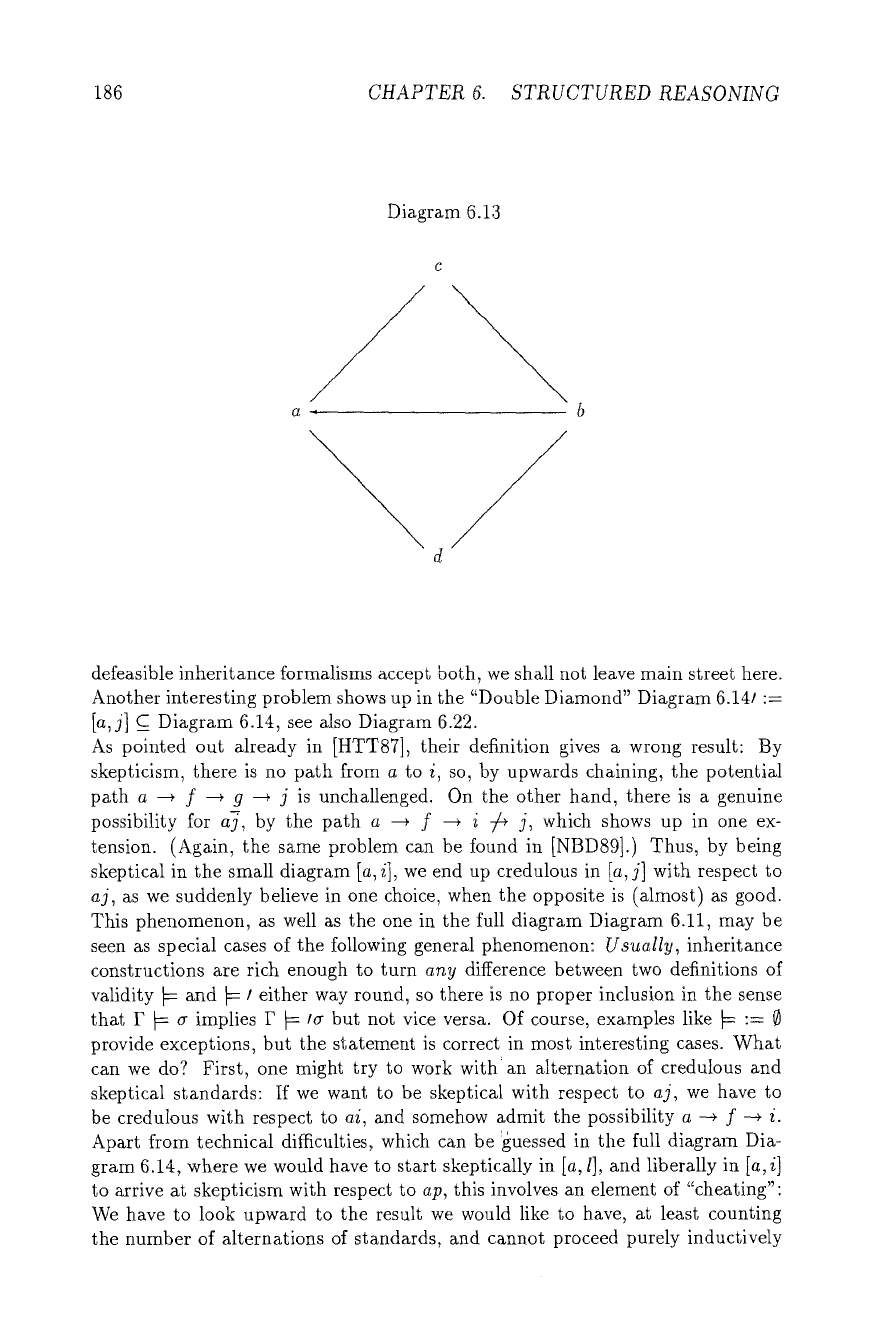
186
CHAPTER 6. STRUCTURED REASONING
Diagram 6.13
C
a .4
d
defeasible inheritance formalisms accept both, we shall not leave main street here.
Another interesting problem shows up in the "Double Diamond" Diagram 6.141 :=
[a,j] C
Diagram 6.14, see also Diagram 6.22.
As pointed out already in [HTT87], their definition gives a wrong result: By
skepticism, there is no path from a to i, so, by upwards chaining, the potential
path a + f -+ g -+ j is unchallenged. On the other hand, there is a genuine
possibility for aT, by the path a -+ f ~ i 74 j, which shows up in one ex-
tension. (Again, the same problem can be found in [NBD89].) Thus, by being
skeptical in the small diagram [a, i], we end up credulous in Is, j] with respect to
a j,
as we suddenly believe in one choice, when the opposite is (almost) as good.
This phenomenon, as well as the one in the full diagram Diagram 6.11, may be
seen as special cases of the following general phenomenon:
Usually,
inheritance
constructions are rich enough to turn
any
difference between two definitions of
validity ~ and ~ t either way round, so there is no proper inclusion in the sense
that F ~ (r implies P ~ ~a but not vice versa. Of course, examples like ~ :=
provide exceptions, but the statement is correct in most interesting cases. What
can we do? First, one might try to work with ~an alternation of credulous and
skeptical standards: If we want to be skeptical with respect to
aj,
we have to
be credulous with respect to
ai,
and somehow admit the possibility a --+ f --+ i.
Apart from technical difficulties, which can be guessed in the full diagram Dia-
gram 6.14, where we would have to start skeptically in [a, l], and liberally in [a, i]
to arrive at skepticism with respect to
ap,
this involves an element of "cheating":
We have to look upward to the result we would like to have, at least counting
the number of alternations of standards, and cannot proceed purely inductively
